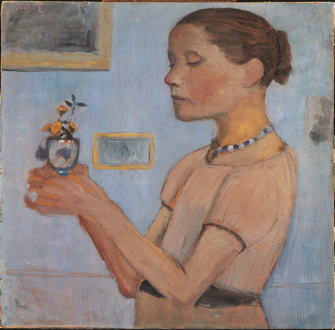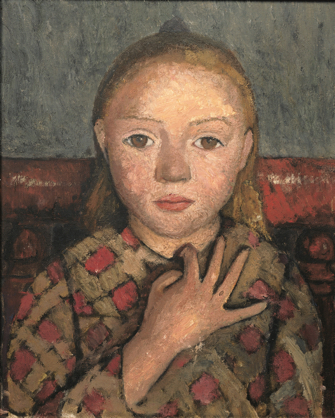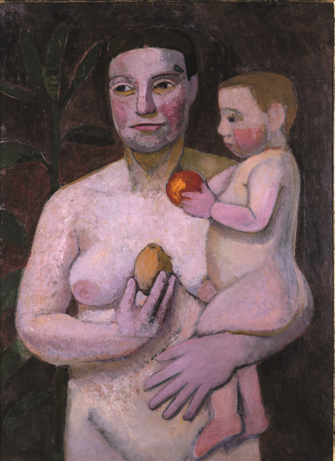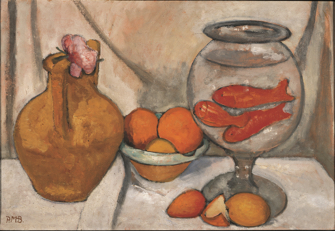The Artist’s Life as
A Short, Intense Celebration

“Jeune Fille Tenant des Fleurs Jaunes dans un Verre” (1902). © Paula-Modersohn-Becker-Stiftung, Brême
Paris museums are hosting a welcome spate of exhibitions of artists whose work has been more or less neglected in France until now, with a George Desvallières retrospective at the Petit Palais and one of Amadeo de Souza-Cardoso at the Grand Palais. Like the latter, Paula Modersohn-Becker (1876-1907), subject of the exhibition “Paula Modersohn-Becker: L’Intensité d’un Regard” at the Musée d’Art Moderne de la Ville de Paris, was a painter who lived a tragically short life and who drew her inspiration from the artistic volcano that was Paris at the turn of the century.
Also like Souza-Cardoso, Paula Becker was born (in Dresden) to a well-heeled family. Her father was an engineer, and her mother came from an aristocratic family. As a teenager, she took drawing courses at St. John’s Wood Art School in London, and she later studied painting at a private art school for women in Berlin (Germany’s School of Fine Arts did not accept female students until 1919).
A turning point in her life came in 1898, when she moved to Worspwede, near Bremen, home to a community of artists who rejected academic strictures and looked to nature, like the Barbizon School in France, for inspiration, painting from life en plein air. They were also interested in depicting the local peasants in all their “authenticity.”
Becker was influenced in both her artistic and personal life by this community. She became close friends with the sculptor Clara Westhoff, who later married the poet Rainer Maria Rilke and was a student of Rodin in Paris. Becker also met her husband-to-be, the artist Otto Modersohn, in Worspwede.
The real upheaval in her life and art came in 1900, however, when she visited Paris for the first time and was able to participate in life-drawing classes with nude models and was exposed to the work of a number of artists who were to greatly influence her own work, including Cézanne, Van Gogh, Gauguin and Rodin.
Eager to break away from the Worspwede group and find her own way, she returned a number of times to Paris (at one point even separating from her husband), stimulated by the excitement of the big city, the courses she took and the artists she met.
Her paintings have a haunting strangeness to them, whether the murky portraits of peasants done in Worspwede or the more brilliantly colored paintings with simplified shapes made after her introduction to the Parisian art world.
The exhibition is divided into categories:

“Portrait de Jeune Fille, les Doigts Écartés devant la Poitrine” (c. 1905) © Paula-Modersohn-Becker-Stiftung, Brême
paintings of children, of mothers and babies, self-portraits, landscapes and still lifes. Many of the faces have a mask-like appearance, even those she made before seeing the famous Fayum portraits in the Louvre.
She was definitely a woman ahead of her

“Mère Nue en Buste, avec un Enfant sur son Bras II” (1906) © Museum Ostwall im Dortmunder U, Dortmund
time. She is thought to be the first to paint full-length portraits of naked women, including herself, and is considered a precursor to German Expressionism. Some of her unflinching self-portraits in hieratic poses made me think of those of Frida Kahlo.
Her still lifes show the influence of Cézanne without imitating him, notably the apples in a beautiful big still life with a pumpkin and a ginger jar (c. 1905). They also anticipate Matisse: in 1904, long before Matisse attempted it, she was trying to capture the

“Still Life with Goldfish Bowl” (1906). © Paula-Modersohn-Becker-Stiftung, Brême
movement of goldfish in a bowl in the vibrant “Still Life with Goldfish Bowl” (1906).
Modersohn-Becker eventually returned to her husband and had the baby she had been longing for. Eighteen days later, only 31 years old, she died of a pulmonary embolism. Her last word was “Schade” (“What a pity!”).
It certainly was a pity that, as with Souza-Cardoso, we will never know where this inventive young painter would have taken her work. Her enthusiasm is summed up well in this almost premonitory quote: “My life is a celebration,” she wrote in 1900, “a short, intense celebration. My powers of perception are becoming finer, as if I were supposed to absorb everything in the few years that are still offered me, everything…. I suck everything up into me.”
Her art may have been neglected since her death, but she has been immortalized in another way as well. Her friend Rilke, deeply moved by her death, was inspired to write his “Requiem for a Friend.”
Musée d’Art Moderne de la Ville de Paris: 11, avenue du Président Wilson, 75116 Paris. Métro: Alma-Marceau or Iéna. Tel.: 01 53 67 40 00. Open Tuesday-Sunday, 10 a.m.-6 p.m. (Thursday until 10 p.m.). Closed on public holidays. Admission: €10. Through August 21, 2016. www.mam.paris.fr
Reader reaction: Click here to respond to this article (your response may be published on this page and is subject to editing).
More reviews of Paris art shows.
© 2016 Paris Update
Favorite